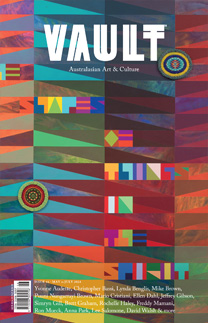Brian Robinson: Lines in the Stars
A childhood spent on Waiben (Thursday Island) still courses through Brian Robinson, informing his sculptures and exquisitely detailed linocuts and prints: the four seasonal winds of kuki, sager, zey and naigai (northwest, southeast, south and north); the migration of birds; the tides and monsoons; the floral blooms and flowering trees.
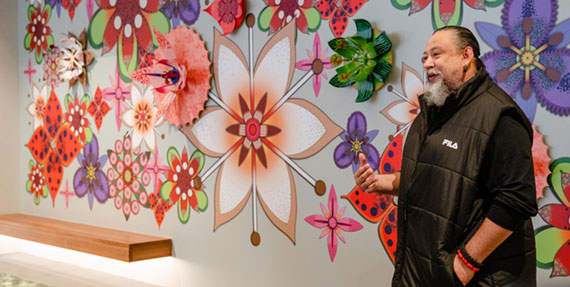
Image credit: Brian Robinson at the unveiling of Spring + Sprout: Guban-Mai (Heal), 2023, foyer installation. Photo: Matthew Smith. Courtesy of the artist and Rio Tinto
When Brian Robinson was born in 1973 on Waiben (Thursday Island), the era of local sorcerers dancing in masks had passed. And yet many of the islanders still lived their lives according to the laws set by these spiritual people, who spoke to higher powers to bring rain and crops, who read star patterns and constellations – all influencing life on Earth.
Robinson, now 50 years old with a grey goatee beard and his hair brushed back, laughs heartily and often as he explains the “very even playing field” of influences on his work. These range from the island sorcery and celestial beings above to his formal art studies of Michelangelo, Leonardo da Vinci and classic Greek and Roman mythology.
Cartoon superheroes were also in the mix. “While I grew up on the Islands, I was still very influenced by popular culture,” he says, seated in his Cairns studio,“that element of escapism out of your usual life into a realm where dreams do become real.” His grandfather shared a stash of Phantom comics with him as a child, “the first character I came across connected to traditional warriors and people in the Straits – many cultures embraced that character.”
The colonial project and arrival of Roman Catholic missionaries to the island in the 19th century meant Robinson would be dragged out of bed for a “boring” mass, made to sit through the minister’s preaching. All the while, his eye would be drawn to Jesus and Mary statues and stained-glass figures, sparking an interest in biblical narratives and leading him to the Renaissance frescoes, and onto the figurative elements in his work today.
“You’d sit there quite bored as a youngster because you were forced to go to church,” he laughs. “It wasn’t your choice, mate, you were forced, particularly by Mum, to go. But a lot of those biblical stories stuck with me – for me it was about reinterpreting those stories and putting an Island slant on them, physically placing that narrative back
up in the Straits.”
Robinson’s family were fisher folk, regularly out on the dinghy diving for fish, cray and turtle. Robinson’s mother,
of the Maluyligal people and with mainland Wuthathi heritage, worked in the pearl fishing offices. His father, a white Scotsman, was an ambulance driver. He also has Malay and Filipino blood.
Robinson’s parents divorced when he was young so Robinson, along with his two olders sisters and younger brother, would go back and forth between Waiben and the Atherton Tablelands near Cairns. Robinson’s ambitions as an artist prompted him to leave Waiben altogether after he turned 18, moving to Cairns to study art at the local TAFE college.
Today, Robinson works from his home studio where art materials have taken over some of the living space. He has three children, all artistically inclined: an adult daughter and two teenage sons.
Earlier, Robinson wanted to be an architectural designer. Perhaps his best-known public work is five giant steel-woven angelfish within a lagoon alongside the Cairns Esplanade, installed in 2003. He grew up weaving as a child, as do many people across the Pacific, where the woven angelfish can be seen adorning table settings around feasting times and ceremonial occasions.
After working at Cairns Art Gallery for 14 years as exhibition curator, exhibition manager and deputy director, Robinson began devoting himself full-time to his practice in 2010, winning the $50,000 Western Australian Indigenous Art Award with two works soon after, in 2013.
The first, a wall-mounted sculpture made of wood, plastic, steel, feathers, plant fibre and shells – titled ...and meanwhile back on earth the blooms continue to flourish (2013) – bursts with flower blooms topped by a masked ancestral being. The second, Up in the heavens the gods contemplate their next move [secret charms are given to man] (2012), is a fine white drawing that blends Ulysses in a wild ocean, da Vinci’s flying machines and more masked ancestral beings.
Having worked with linocuts and prints for many years, Robinson had long wanted to animate his art. In 2022 he collaborated on his first animation for the children’s art centre in the Gallery of Modern Art, Meanjin/Brisbane. He also recently undertook the more ambitious work Zugubal: The Winds and Tide Set the Pace (2023), as part of the Shadow Spirit exhibition upstairs in Melbourne’s Flinders Street railway station.
Part of the city’s annual winter RISING festival, Shadow Spirit included 14 new, large-scale commissions involving some 30 First Nations artists from across the country, and 100 specialist fabricators. Collaborating with digital design company Grumpy Sailor, Robinson’s work immersed audiences in an animation of zugubal, celestial beings that start off life as constellations.
“They’re basically these spiritual beings, star clusters that influence life back on Earth, especially through the Torres Strait where the zugubal spirits lie,” he says.
He could not resist adding some pop culture surprises – including Pac-Man and storm troopers – into the two original linocuts that spawned the immersive animation, including one based on the tagai star cluster narrative.
Given the intricate detail in his works, can a slip of the hand ruin a linocut? Robinson laughs.
“Any of those little slips can be fixed during the printing process. But generally, when I start a piece of lino, my go-to size has been the one-metre by two-metre block because it fits nicely on one of the benches I have here in my studio, a little bit bigger than your average kitchen tabletop.”
“I’ll throw a piece of lino straight on that, and before I start I know roughly what the narrative will be. I know the main elements to initially put down, so all of that will be composed first. Then I look for areas where the narrative can skirt off into something else, so I’ll then add those additional elements. When I’ve got a good composition happening, I’ll start to carve. That’s when I’ll start to add in the little pop culture references, hidden among all the patterns.”
Robinson’s trips back to Waiben have been infrequent. “I’d like to say that I get home on a regular basis, but that’s not the case, unfortunately. It’s only a two-hour QantasLink flight north of Cairns, a quick ferry and bus ride, it doesn’t take long at all. It’s more the timing of everything, with my busy lifestyle.”
The artist reminisces now about star gazing on Waiben, and the cultural knowledge his family taught him. “You’ll sit there with your extended family – your uncles, aunties, grandparents – and you’ll hear all of these stories of life in the Islands, what it was like for them and their parents and grandparents,” he says.
“You sit there and slowly absorb a lot of that material, but I don’t think you fully understand it until you get a little bit older and wiser yourself and you start to look at a lot of those stories as inspiration for the artworks.”
Brian Robinson is represented by Mossenson Galleries, Perth and Onespace, Brisbane.
mossensongalleries.com.au
onespace.com.au

Image credit: Brian Robinson, Citizens Gateway to the Great Barrier Reef, 2017, polished stainless steel surface, approx 6 x 11 m. Photo: Roger D'Souza. Courtesy of UAP
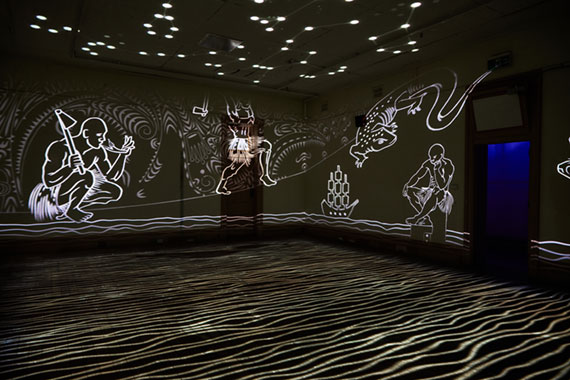
Image credit: Brian Robinson, Zugubal: The Winds and Tides set the Pace, 2023 Installation view, Shadow Spirit, RISING Festival, Melbourne, 2023. Photo: Eugene Hyland
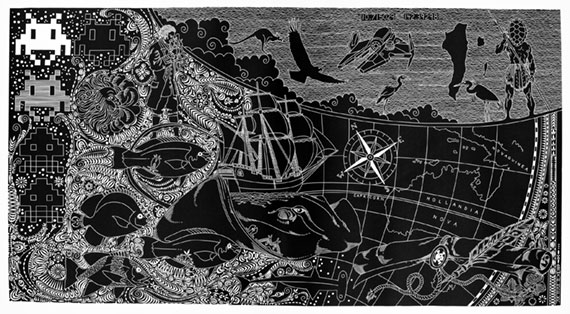
Image credit: Brian Robinson, Bedhan Lag: Land of the Kaiwalagal, 2019, linocut mounted onto board, 100 x 185 cm. Courtesy the artist
This article was originally published in VAULT Magazine Issue 43 (August – October 2023).
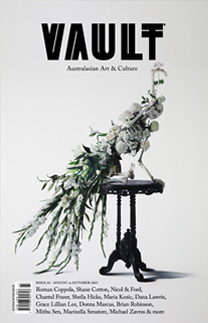
Click here to Subscribe







